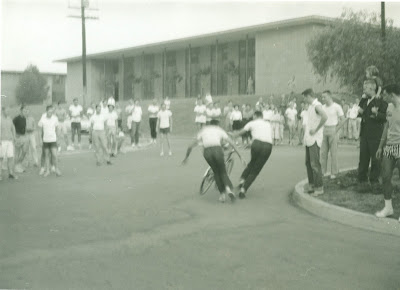Claremont Racing II: Tag Team at the Colleges...
We are all familiar with the Little 500 Bicycle Race made famous by the film Breaking Away. That team-effort race had its start in 1951 and sees teams of riders competing against one another in tag-team fashion; one rider will circle the course for any number of laps before handing the bike off to a teammate. The race continues in that pattern for a specified number of laps.
The Claremont Colleges Digital Library contains several photographs showing the action during similar races along, what appears to be Platt Blvd between Harvey Mudd and Scripps Colleges, and were taken between the late 1950s and early 1960s. The races clearly involved hand-offs, or bike exchanges (which don't always go smoothly), though unlike the University of Indiana's Little 500, these races were not run around the school track, but on campus streets. It would be interesting to know during which, and how many, years these races were run, how teams were formed, length in distance or time, etc. The races would seem to be true grassroots efforts; people will always want to race, no matter what the pros do to ruin things at their level.
There are only a few photos in this bicycle race collection, and many of the same digitized images are found in other university collections, such as the University of Delaware. I am not sure if an alumnus gave copies to multiple schools, or what, but there you go. Most of the images show the action from a more distant perspective (the second one above is as close as you get), but the action is only one point of interest. They also provide glimpses into student life at the time, provide a time capsule of campus evolution, and link past to present. And then there are the bikes; while some of them appear to be more race attuned, others are typical student commuters with fenders, chain guards, and head lights. I could swear, some of them can still be spotted around the campuses today.
Early in 2012 (February) I did a short post on Claremont as a hotbed of cycling. From infrastructure for everyday commuting by bike to collegiate and professional racing, cycling has long been prominent in the city. Lately I have become increasingly interested in researching the history of racing within the city, from the racers, teams, organizers, and the races; there will be short posts like this one, and then at the end (however far ahead that may be) I will put it all together. Part I in the series is here.


Comments
Post a Comment